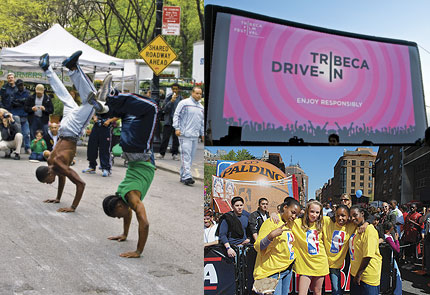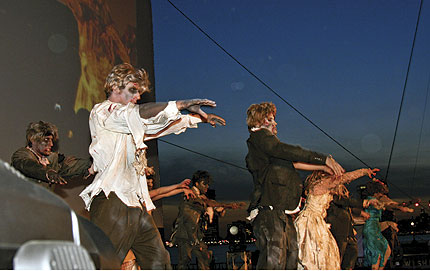film
Coming of Age
A crowd-pleasing festival marks its new place in the film industry
by Renée Alfuso / CAS ’06
There’s no doubt that the TriBeCa Film Festival has had something of a Willy Wonka effect on its community. Each spring, it temporarily transforms the neighborhood into a giant playground where movies come to life—blankets and lawn chairs lined the Hudson for a lavish luau when the animated comedy Surf’s Up screened, and thousands joined in a zombie dance disco to celebrate the 25th anniversary of Michael Jackson’s Thriller. There’s also the basketball shooting contests and football theme park set up for movies premiering on TriBeCa/ESPN Sports Day. Since it was launched from the ashes of 9/11—in just 120 days—more than two million visitors have flocked to the festival, and it has screened over 1,100 films from more than 80 countries. It has also generated more than $530 million in economic activity for lower Manhattan. Festival Co-Founders Robert de Niro and Jane Rosenthal, who has produced many of the actor’s films,
including Meet the Parents.
Festival Co-Founders Robert de Niro and Jane Rosenthal, who has produced many of the actor’s films,
including Meet the Parents.
The purpose of most film festivals, however, is not just to screen movies but to sell films to distributors and reach the broadest of audiences. With this in mind, Jane Rosenthal (GAL ’77), who co-founded TriBeCa with Robert De Niro (HON ’96), her film partner of more than 20 years, is retooling the festival to be both a neighborhood carnival and a serious cinematic contender. In 2007, she created a year-round industry department to put those who acquire films directly in touch with the artists who make them. That same year, 34 films that premiered at TriBeCa were acquired for distribution—almost double the number from the previous year. Documentaries have found the most success, with Taxi to the Dark Side taking home the 2008 Oscar and Pray the Devil Back to Hell landing on the short list this year after both premiered at TriBeCa. “Our birth was about what we could do for our community, so that will always be our roots,” Rosenthal says. But the festival is making its name by striking an unusual balance among the fun, art, and business of film.
 Each Spring, Tribeca takes over the streets outside the festival’s film screenings with (counterclockwise)
Performers, Games, and a drive-in on the Hudson.
Each Spring, Tribeca takes over the streets outside the festival’s film screenings with (counterclockwise)
Performers, Games, and a drive-in on the Hudson.
Seven years old, TriBeCa is still the new guy amidst a sea of well-established film festivals: Cannes began back in 1946, the New York Film Festival is approaching its 50th run, and even the hip indie-fest Sundance started out as the United States Film Festival in 1978, before Robert Redford transformed it years later. The media was quick to compare TriBeCa to these predecessors and early on criticized it for being too broad and lacking a clear enough identity. “We had so much focus on us and everybody was looking at us and saying, ‘What are you going to be? What are you going to be?’” says Rosenthal, adding that it took years before Sundance established itself with the 1989 screening of sex, lies, and videotape.
Right away, though, TriBeCa was able to separate itself from its uptown neighbor. The New York Film Festival, which The New York Times has described as “elitist,” selects just 28 features each year with no competitive categories or prizes. In contrast, TriBeCa recognizes outstanding films with an array of awards for features, shorts, and documentaries, and a handful of prizes for films made in or about New York.
For viewers, the NYFF feels like a private Upper West Side cocktail soiree to TriBeCa’s raucous downtown block party, where the box office hit Star Wars Episode II: Attack of the Clones premiered alongside the chick-flick Divine Secrets of the Ya-Ya Sisterhood, just blocks from the Oscar-nominated Norwegian film Elling during the inaugural festival. “It’s New York and there’s not just one type of filmgoer here,” director of programming David Kwok explains. “You have your cinephiles, but you also have the recreational filmgoer, so our hope is to be able to cross those audiences.”
 Michael Jackson’s Thriller comes to life with a zombie dance disco.
Michael Jackson’s Thriller comes to life with a zombie dance disco.
“The key is to have as many voices as you can and especially voices that are not often explored or exposed,” adds Sharon Badal (TSOA ’80, GAL ’92), who programs short films for the festival in addition to her role as associate teacher at the Tisch School of the Arts. Those voices come from all over the world, in foreign films that would otherwise have a difficult time reaching U.S. audiences, but also from the festival’s own backyard with community-based cinema like those discovered through the TriBeCa All Access program, which connects filmmakers from underrepresented groups with industry professionals.
As they’ve found their equilibrium over the years, Rosenthal says, the festival has refocused its program by cutting down the number of features it screens to 85 from as many as 174 in 2006. Many critics took note of the change, as Stephen Holden of The New York Times wrote last year, “A sign of the festival’s confidence is its willingness to shrink. No longer does it project the panicky sense of an event grabbing too many things offered to it in a mad scramble to demonstrate its size and importance.”
What hasn’t changed is the focus on its community audience. This year’s festival kicks off with the world premiere of Woody Allen’s Whatever Works, which marks his cinematic return to New York after shooting his last four films abroad. And there are still special neighborhood events like the TriBeCa Drive-In outdoor screenings and the Family Festival Street Fair, where costumed characters and performers roam along rows of tents offering local food, arts and crafts, puppet and magic shows, and face painting. “[Here] you don’t have to just be an industry insider to have access to the world of the film festival,” Rosenthal says. “Anybody can come.” And this won’t change because while TriBeCa is finding its place, it hasn’t lost the spirit of why it came into being. Rosenthal explains: “As there were steel workers and firefighters and police who did their jobs, as filmmakers, the only thing we knew how to do was to put on a show.”
The 2009 TriBeCa Film Festival runs from April 22-May 3. For the full lineup, visit www.tribecafilm.com/festival.
Photos Courtesy the Tribeca Film Festival







